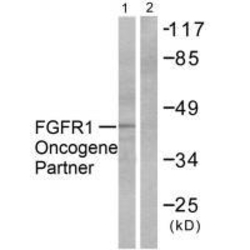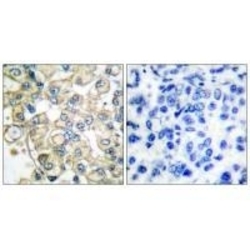Antibody data
- Antibody Data
- Antigen structure
- References [2]
- Comments [0]
- Validations
- Western blot [1]
Submit
Validation data
Reference
Comment
Report error
- Product number
- A06907 - Provider product page

- Provider
- Boster Biological Technology
- Product name
- Anti-FGFR1 Oncogene Partner FGFR1OP Antibody
- Antibody type
- Polyclonal
- Description
- Polyclonal antibody for FGFR1OP detection. Host: Rabbit.Size: 100μl. Tested applications: IHC. Reactive species: Human. FGFR1OP information: Molecular Weight: 43065 MW; Subcellular Localization: Cytoplasm, cytoskeleton, microtubule organizing center, centrosome . Associated with gamma-tubulin; Tissue Specificity: Ubiquitous. Highly expressed in heart, liver, muscle, kidney, intestine, colon, adrenal gland, prostate, testis, and pancreas.
- Reactivity
- Human, Mouse, Rat
- Host
- Rabbit
- Vial size
- 100μl
- Concentration
- 0.5-1mg/ml, actual concentration vary by lot. Use suggested dilution ratio to decide dilution procedure.
- Storage
- Store at -20°C for one year, at 4°C for one month. We suggest the antibody be aliquoted into small vials and stored frozen at -20°C upon receiving. Avoid repeated freezing and thawing.
Submitted references Bufalin suppresses the migration and invasion of prostate cancer cells through HOTAIR, the sponge of miR-520b.
Regulation of 25-hydroxyvitamin D-1-hydroxylase and 24-hydroxylase in keratinocytes by PTH and FGF23.
Zhang JJ, Zhou XH, Zhou Y, Wang YG, Qian BZ, He AN, Shen Z, Hu HY, Yao Y
Acta pharmacologica Sinica 2019 Sep;40(9):1228-1236
Acta pharmacologica Sinica 2019 Sep;40(9):1228-1236
Regulation of 25-hydroxyvitamin D-1-hydroxylase and 24-hydroxylase in keratinocytes by PTH and FGF23.
Wu W, Fan H, Jiang Y, Liao L, Li L, Zhao J, Zhang H, Shrestha C, Xie Z
Experimental dermatology 2018 Nov;27(11):1201-1209
Experimental dermatology 2018 Nov;27(11):1201-1209
No comments: Submit comment
Supportive validation
- Submitted by
- Boster Biological Technology (provider)
- Main image

- Experimental details
- Western blot analysis of extracts from HepG2 cells, using FGFR1 Oncogene Partner antibody A06907.
- Additional image

 Explore
Explore Validate
Validate Learn
Learn Western blot
Western blot Immunohistochemistry
Immunohistochemistry